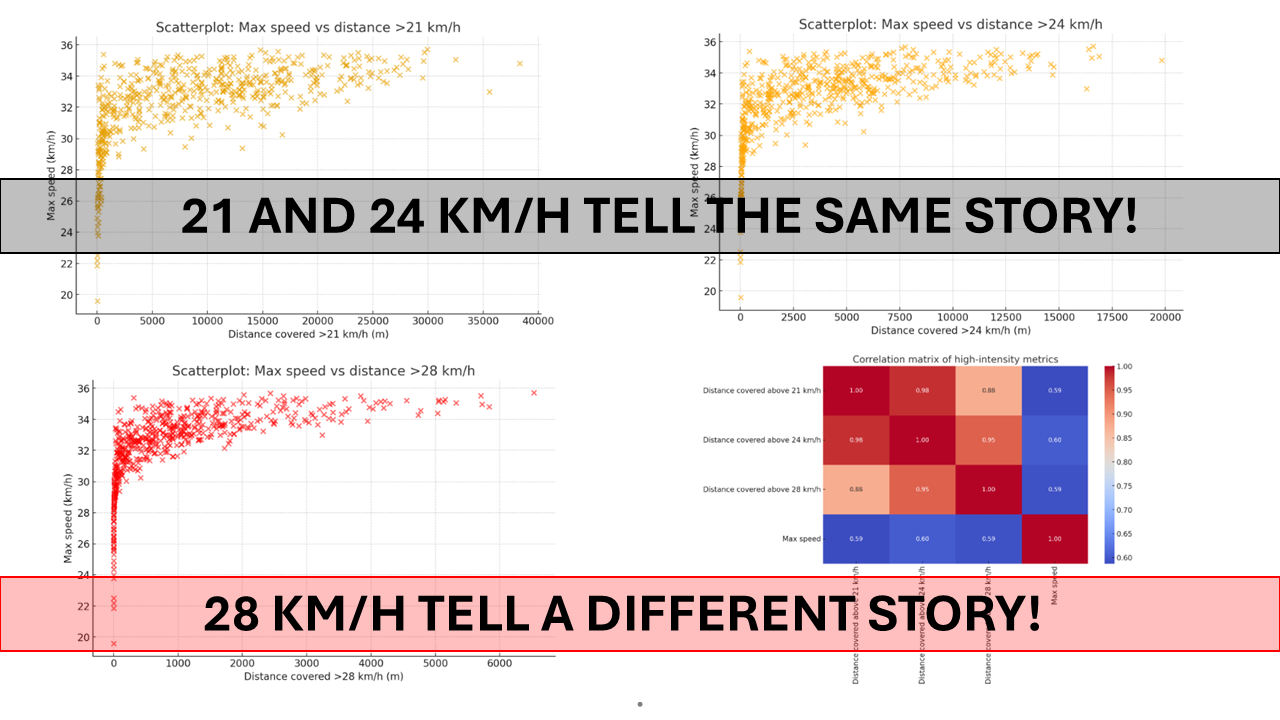
26 Sep If you analyze high-intensity running at >21 km/h and >24 km/h, you’re wasting your time—they measure the same thing.
Picture this: you’re reviewing the GPS report from the latest match. The dashboard splits high-intensity running into two familiar thresholds: above 21 km/h and above 24 km/h. These numbers guide training load, recovery, even tactical plans. But here’s the uncomfortable question: are these two thresholds really telling you different things—or are we just double-counting the same reality?
This was the central question behind our research at the Football Intelligence & Performance Department of LALIGA, using data from the entire 2024/25 LALIGA EA Sports season. And the answer challenges a long-standing tradition in football analysis.
From convention to evidence
For years, practitioners have separated >21 km/h (“low high-intensity running”) and >24 km/h (“high high-intensity running”). The idea was that the split adds nuance to understanding players’ efforts. But when we tested it scientifically, the results told another story.
What we found
1. 21 and 24 km/h tell the same story
The rankings of players covering the most distance above 21 km/h and above 24 km/h were almost identical. The overlap is so strong that distinguishing them is redundant.
Top 10 players – Distance >21 km/h
| Rank | Player | Team | Distance covered above 21 km/h (m) |
|---|---|---|---|
| 1 | RAPHINHA | FC BARCELONA | 38,324 |
| 2 | S CARDONA | VILLARREAL CF | 35,565 |
| 3 | PEP CHAVARRIA | RAYO VALLECANO | 32,505 |
| 4 | ANDREI | RAYO VALLECANO | 29,952 |
| 5 | ALVARO | RAYO VALLECANO | 29,677 |
| 6 | ARESO | CA OSASUNA | 29,584 |
| 7 | KOUNDE | FC BARCELONA | 29,504 |
| 8 | BALDE | FC BARCELONA | 28,212 |
| 9 | PUADO | RCD ESPANYOL DE BARCELONA | 28,059 |
| 10 | L RIOJA | D ALAVES | 27,717 |
Top 10 players – Distance >24 km/h
| Rank | Player | Team | Distance covered above 24 km/h (m) |
|---|---|---|---|
| 1 | RAPHINHA | FC BARCELONA | 19,827 |
| 2 | PEP CHAVARRIA | RAYO VALLECANO | 16,889 |
| 3 | ANDREI | RAYO VALLECANO | 16,600 |
| 4 | ARESO | CA OSASUNA | 16,532 |
| 5 | ALVARO | RAYO VALLECANO | 16,396 |
| 6 | S CARDONA | VILLARREAL CF | 16,292 |
| 7 | L PEREZ | REAL VALLADOLID CF | 14,751 |
| 8 | KOUNDE | FC BARCELONA | 14,696 |
| 9 | DE FRUTOS | RAYO VALLECANO | 14,603 |
| 10 | DIEGO LOPEZ | VALENCIA CF | 13,979 |
*Seven players appear in both lists. The message is clear: 21 and 24 km/h are statistical twins.
2. 28 km/h changes the narrative
When we looked at sprints above 28 km/h, the rankings shifted. Explosive attackers who were invisible in the previous lists suddenly emerged:
Top 10 players – Distance >28 km/h
| Rank | Player | Team | Distance covered above 28 km/h (m) |
|---|---|---|---|
| 1 | ANDREI | RAYO VALLECANO | 6,532 |
| 2 | RAPHINHA | FC BARCELONA | 5,837 |
| 3 | ARESO | CA OSASUNA | 5,725 |
| 4 | ALVARO | RAYO VALLECANO | 5,708 |
| 5 | PEP CHAVARRIA | RAYO VALLECANO | 5,322 |
| 6 | MORO | REAL VALLADOLID CF | 5,151 |
| 7 | VINI JR | REAL MADRID | 5,126 |
| 8 | MBAPPE | REAL MADRID | 5,053 |
| 9 | WILLIAMS | ATHLETIC CLUB | 5,049 |
| 10 | L PEREZ | REAL VALLADOLID CF | 5,036 |
*Notice who enters only here: Vini Jr., Mbappé, and Iñaki Williams.
They don’t top the charts at >21 or >24 km/h because their game is not about accumulating meters at moderate high intensity. Their value lies in explosive, decisive sprints—and >28 km/h finally makes them visible.
Why this matters for coaches and analysts
- Stop double-counting: Distances above 21 and 24 km/h measure the same reality.
- Refocus on what matters:
- One global measure of high-intensity running (choose 21 or 24, no need for both).
- One measure of sprinting (>28 km/h), closely linked with maximum speed.
- Tactical profiles:
- Midfielder with high >21 and >24 but low >28 → consistent intensity, low sprint exposure.
- Winger with high >28 and high max speed → dangerous sprinter, decisive in transitions.
- Defender with high max speed but low >28 → capacity exists, but game model doesn’t demand it.
The bigger picture
Football science evolves by questioning conventions. Our findings show that splitting 21 and 24 km/h is a false distinction, while >28 km/h adds real tactical and physical insight. For practitioners, this means one thing: look beyond tradition, and focus on what truly separates players.


